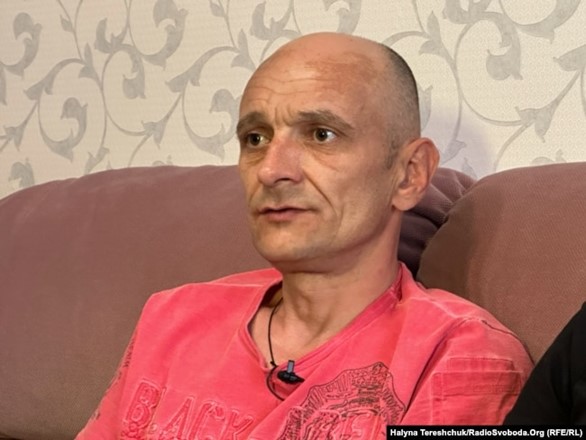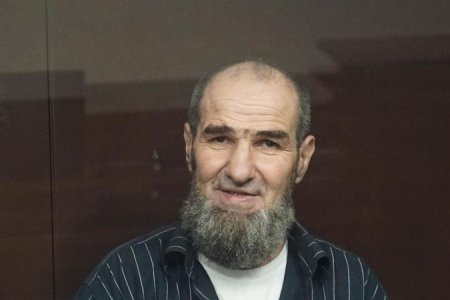
Mykola Shyptur spent nine years in Russian captivity for a pro-Ukrainian demonstration in occupied Crimea and, probably, because the appearance of a police officer prevented the Russian paramilitaries from simply abducting and killing him. Shyptur is finally back in his native Ivano-Frankivsk with his wife, Yulia and their son, Serhiy, who was just ten when his father was imprisoned. In an interview to Radio Svoboda, he gave further details of his capture, as well as of the torture and ill-treatment he was subjected to in a Russian-controlled harsh-regime prison colony in occupied Crimea. He also spoke of the particular torment after Russia’s full-scale invasion, with his only source of ‘information’ being Russian state propaganda that claimed that “Ukraine no longer exists”.
As reported, Shyptur had already spent two years in captivity when lawyers from the Ukrainian Helsinki Human Rights Union learned of his case and pointed to the clear political elements in an alleged criminal conviction.
Shyptur had played an active role in the Euromaidan protests, now known as the Revolution of Dignity, and had been involved in guarding the Kyiv City Council, which was seized on 1 December 2013 by one of the groups of activists. He and three other Maidan activists (Serhiy Tkachuk, Vladislav Polishchuk – a doctor, and Olha Cherniatynska) were asked to come to Crimea, which Russia had already invaded, and to help at a planned mass rally in Sevastopol. The rally was in support of Ukrainian unity, and timed to coincide with the 200th anniversary of the birth of the great Ukrainian poet Taras Shevchenko on 9 March 2014. The Russian and pro-Russian ‘self-defence’ armed paramilitaries had already demonstrated savage brutality against anyone showing support for Ukraine, and it was hoped that the four activists would both help to protect the pro-Ukrainian demonstrators and, if needed, provided medical assistance. A local activist had rented a flat for them, and they spent the first two nights posting leaflets that they had brought from Kyiv, explaining just why the so-called referendum that Russia was using to rubberstamp its annexation, was an illegal farce.
As feared, the peaceful demonstration, at which women with Ukrainian flags and in embroidered blouses read Shevchenko’s poetry, etc., turned violent with the arrival of Russian / pro-Russian provocateurs. Since Shyptur was slightly injured, and Tkachuk had a bad rib fracture, the four decided that they should remain in the flat for a while, since the paramilitaries had seen their faces and would be hunting for them.
It remains unclear why Cherniatynska decided to leave the flat, but this did prove as disastrous as feared. When Shyptur realized that she had returned with armed paramilitaries, he tried to get away, with four of the paramilitaries behind him. He understood that he could not fight four men, and fired the pistol that he had with him at the ground, hoping that this would scare them off. It did not, and he was eventually seized and savagely tortured by the paramilitaries. It was only later that the ‘police’, who were already under Russian control, intervened.
Although the appearance of the police led to charges being fabricated against him, and not his assailants, they may well have saved his life. The armed paramilitaries had already tortured and murdered Refat Ametov, after abducting him from his solitary protest against Russia’s invasion, and they are suspected of being behind the enforced disappearances of several other Ukrainian civic activists. A propaganda version of the events was shown on Russian-controlled local TV, with paramilitaries telling a police officer about how they had “detained” the young woman and how Shyptur had started shooting. Shyptur was ‘tried’ illegally under Russian law, with the version presented being that the shots were not in the air, but aimed three times at A.V. Kulish, a member of ‘Russian Bloc’ (one of the armed paramilitaries). This, it was claimed, had been attempted murder, with no heed taken of the danger which Shyptur had faced from his alleged victim. This armed paramilitary, helping Russian soldiers without insignia in their violent seizure of Ukrainian territory, was called “a person carrying out his official duties or civic duty” in the 10-year sentence passed on Shyptur on 28 April 2015 by the occupation ‘Gagarin district court’ in Sevastopol. A further charge of illegally transporting weapons was dropped at appeal level with this reducing the sentence to nine years. His captors used torture to force Shyptur into providing the ‘testimony’ against himself demanded.
Shyptur spent the entire nine years at a harsh-regime prison colony in occupied Simferopol. The conditions were unsanitary and appalling, with the prisoners, he recounts, receiving only enough food so that they didn’t die. Yulia had first learned of her husband’s whereabouts from his lawyer, and, at least until Russia’s full-scale invasion, was able to get some parcels with food and other essential items to him. She was only able to see him for the first time in 2020.
At one stage, Shyptur was thrown into a punishment cell for fifteen days. He had refused to take part in the building work of a new prison for those detained by the Russian FSB. Shyptur understood that this would be used for imprisoning Ukrainians and would have nothing to do with it.
The worst day of all of his torment was 24 February 2022, when Russian began its full-scale invasion. There was the sense of powerlessness that he could do nothing to help his family and his country.
“On Russian television they claimed that Ukraine was over, that it no longer existed. I saw missiles falling and recognized the place where this happened in Ivano-Frankivsk. That is close to where my mother lives. It was very hard, I was wound up, and didn’t know where to get information which was not available. Unofficial information began coming that Ukrainians were actively resisting”,
He remained in a state of immense stress for the remainder of his sentence, and then the further months in which he was held in a centre for people awaiting deportation, before being able to return to Ukraine via Georgia and Armenia.
During that last year of imprisonment, Shyptur reports that Ukrainian prisoners were held in the premises built on the territory of the prison colony. The word Shyptur uses could refer to prisoners of war, however it is known that a large number of the civilian hostages whom the Russians abducted from occupied parts of Kherson and Zaporizhzhia oblast have also been held at what is now known as SIZO [remand prison] No. 2. The FSB, Shyptur says, took them away in the night and brought them back in the morning. “People were tortured. Everything there was top secret with that unit, nobody knows how many people are held there, and what is happening. You see only that a car leaves and arrives, and that in the morning, a doctor runs in.”
Shyptur adds that the Russians do not have any limits, and all forms of torture are applied.
Now 45, Shyptur looks older after his 9-year ordeal that finally ended on 18 May 2023. He is, thankfully, home in Ukraine.
Others are not. Even without the huge number of hostages seized since February 2014, Russia is holding around 140 Crimean Tatar and other Ukrainian political prisoners, most held in the worst of Russian penal institutions.
Please help to ensure that their voices are heard!
Held since 2014
Valentin Vyhivsky
Valentin Vyhivsky: Eight years of torture in Russian captivity for being Ukrainian
Viktor Shur
Russia called a disused aerodrome a state secret to sentence Ukrainian to 12 years
Details about other victims can be found at the text below, and here
Prohibited remembrance of Crimean Tatar genocide and mounting terror in Russian occupied Crimea



